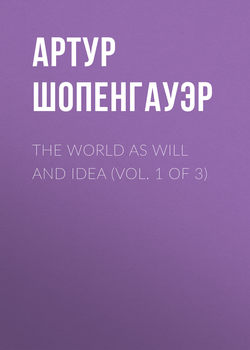The World as Will and Idea (Vol. 1 of 3)

Реклама. ООО «ЛитРес», ИНН: 7719571260.
Оглавление
Артур Шопенгауэр. The World as Will and Idea (Vol. 1 of 3)
Translators' Preface
Preface To The First Edition
Preface To The Second Edition
First Book. The World As Idea. First Aspect. The Idea Subordinated To The Principle Of Sufficient Reason: The Object Of Experience And Science
Second Book. The World As Will. First Aspect. The Objectification Of The Will
Third Book. The World As Idea. Second Aspect. The Idea Independent Of The Principle Of Sufficient Reason: The Platonic Idea: The Object Of Art
Fourth Book. The World As Will. Second Aspect. The Assertion And Denial Of The Will To Live, When Self-Consciousness Has Been Attained
Отрывок из книги
I propose to point out here how this book must be read in order to be thoroughly understood. By means of it I only intend to impart a single thought. Yet, notwithstanding all my endeavours, I could find no shorter way of imparting it than this whole book. I hold this thought to be that which has very long been sought for under the name of philosophy, and the discovery of which is therefore regarded by those who are familiar with history as quite as impossible as the discovery of the philosopher's stone, although it was already said by Pliny: Quam multa fieri non posse, priusquam sint facta, judicantur? (Hist. nat. 7, 1.)
According as we consider the different aspects of this one thought which I am about to impart, it exhibits itself as that which we call metaphysics, that which we call ethics, and that which we call æsthetics; and certainly it must be all this if it is what I have already acknowledged I take it to be.
.....
It is not, as is commonly supposed, an essential characteristic of a concept that it should contain much under it, that is to say, that many ideas of perception, or it may be other abstract ideas, should stand to it in the relation of its ground of knowledge, i. e., be thought through it. This is merely a derived and secondary characteristic, and, as a matter of fact, does not always exist, though it must always exist potentially. This characteristic arises from the fact that a concept is an idea of an idea, i. e., its whole nature consists in its relation to another idea; but as it is not this idea itself, which is generally an idea of perception and therefore belongs to quite a different class, the latter may have temporal, spacial, and other determinations, and in general many relations which are not thought along with it in the concept. Thus we see that several ideas which are different in unessential particulars may be thought by means of one concept, i. e., may be brought under it. Yet this power of embracing several things is not an essential but merely an accidental characteristic of the concept. There may be concepts through which only one real object is thought, but which are nevertheless abstract and general, by no means capable of presentation individually and as perceptions. Such, for example, is the conception which any one may have of a particular town which he only knows from geography; although only this one town is thought under it, it might yet be applied to several towns differing in certain respects. We see then that a concept is not general because of being abstracted from several objects; but conversely, because generality, that is to say, non-determination of the particular, belongs to the concept as an abstract idea of the reason, different things can be thought by means of the same one.
It follows from what has been said that every concept, just because it is abstract and incapable of presentation in perception, and is therefore not a completely determined idea, has what is called extension or sphere, even in the case in which only one real object exists that corresponds to it. Now we always find that the sphere of one concept has something in common with the sphere of other concepts. That is to say, part of what is thought under one concept is the same as what is thought under other concepts; and conversely, part of what is thought under these concepts is the same as what is thought under the first; although, if they are really different concepts, each of them, or at least one of them, contains something which the other does not contain; this is the relation in which every subject stands to its predicate. The recognition of this relation is called judgment. The representation of these spheres by means of figures in space, is an exceedingly happy idea. It first occurred to Gottfried Plouquet, who used squares for the purpose. Lambert, although later than him, used only lines, which he placed under each other. Euler carried out the idea completely with circles. Upon what this complete analogy between the relations of concepts, and those of figures in space, ultimately rests, I am unable to say. It is, however, a very fortunate circumstance for logic that all the relations of concepts, according to their possibility, i. e., a priori, may be made plain in perception by the use of such figures, in the following way: —
.....